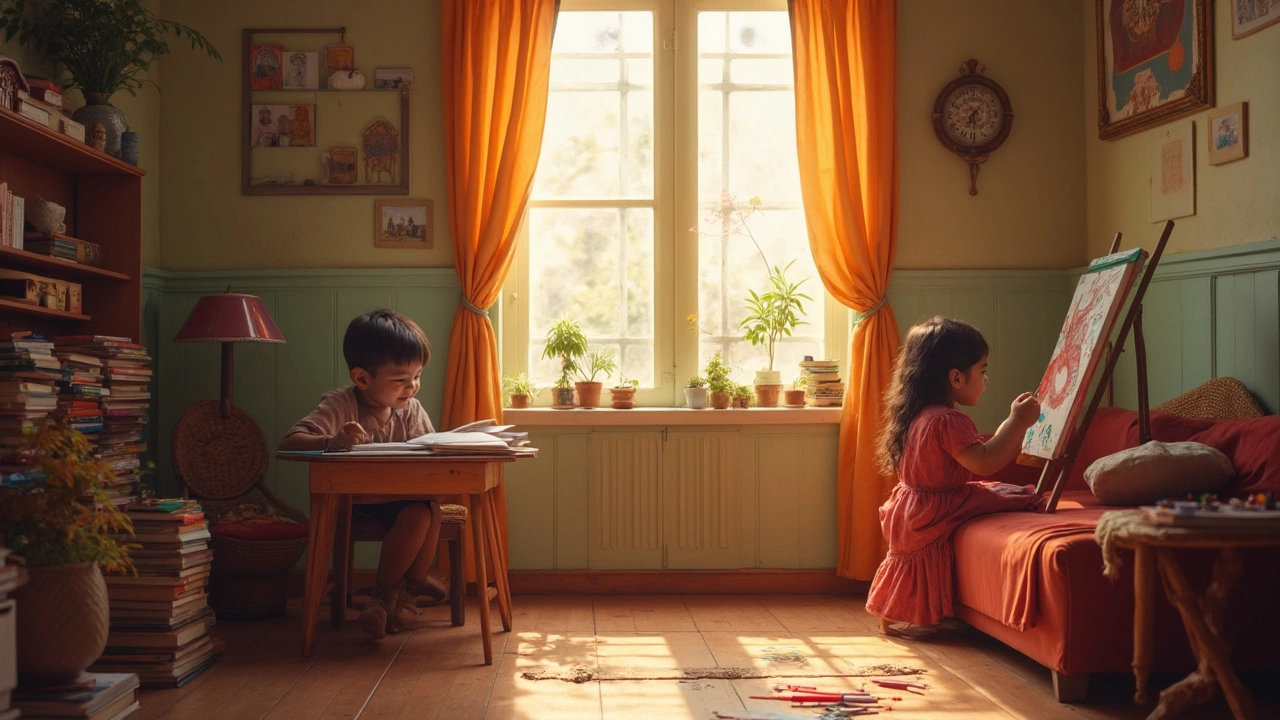Ever wonder how much free time is enough for kids? It’s pretty wild if you think about how jam-packed a child's schedule can get with school, homework, and after-school clubs. Yet, giving kids the freedom to just be kids is super important too. These days, though, we often juggle making sure they get all the opportunities while letting them chill and explore their own interests.
The big question is, what’s a good balance here? Like, how much structure is helpful, and when does it start cramping their creativity? Kids need that downtime not just for play but also for their mental and emotional well-being. Finding that sweet spot can be tricky, right?
- Importance of Free Time
- Balancing Structured and Unstructured Activities
- Factors Affecting Free Time Needs
- Benefits of Downtime for Kids
- Practical Tips for Parents
Importance of Free Time
Free time for kids is way more crucial than some folks realize. It’s not just about letting them kick back and relax, but it's also about giving them a chance to explore and learn on their own terms. This exploration is key to their growth. When kids have unstructured time, they're not only having fun but they're also developing important life skills like problem-solving and creativity.
Here's a fun fact: kids who get a good balance between structured and free time often show more confidence and better social skills. It’s like, when they have the chance to play and make decisions without adult interference, they build those all-important independence muscles. That’s the kind of growth you can’t always get from a packed schedule of structured activities.
Experts even say that free play helps with brain development. Letting kids engage in activities they choose means boosting their emotional health and well-being. It’s basically giving them practice in real-world problems but in a totally fun way. So, a little downtime isn't just a break; it’s a chance for your child to grow and thrive.
And what about after-school clubs? They're awesome but strike a balance. Kids should enjoy these activities without feeling overwhelmed. It's all about ensuring they have just enough to keep them excited and engaged without turning their whole childhood into a checklist.
So, next time you’re wondering if it’s okay for your child to just chill out for a bit, remember, it’s not just okay, it’s actually helping them grow into well-rounded individuals. That’s the unspoken magic of free time!
Balancing Structured and Unstructured Activities
Finding that magic line between organized routines and free-flowing downtime is a bit like cooking—everyone has their own recipe that works best. So how do you strike a balance between keeping kids busy with after-school clubs and letting them have some laid-back time?
Structured activities like sports, music lessons, and academic clubs are fantastic for teaching discipline, teamwork, and certainly giving them a mix of child development skills. According to some clear data, about 75% of teens say they learn valuable life lessons through extracurricular activities.
On the flip side, here's where the unstructured part plays its role. Free time lets kids process what they’ve learned and explore interests free from external pressures. Kids can create their own games, build incredible imaginary worlds, or just relax—and all this helps boost creativity and independence.
But how do you decide how much is too much? A good rule of thumb might be aiming for a balance where kids have at least an hour or two of free time each day. Beyond that, you can let them help choose which structured activities they genuinely enjoy rather than what looks good on paper.
Parents can keep an eye on signs their child might be overwhelmed by too many commitments. Notice if they're feeling exhausted or losing interest in activities they used to love? That’s a cue to step back and let them have more free time to just be themselves.
| Type of Activity | Benefits |
|---|---|
| Structured Activities | Social skills, discipline, resilience |
| Unstructured Free Time | Creativity, independence, relaxation |
A balanced approach tunes in to each child’s unique needs, interests, and social dynamics. Shuffling around schedules to find time for both is an art, but one that pays off in crafting a well-rounded, happy kid.

Factors Affecting Free Time Needs
Every child is unique, and their need for free time can vary based on several factors. It’s not just about filling in gaps between school and bedtime, but understanding what fits each child’s lifestyle and personality.
First off, age plays a big role. Younger kids, say those in early elementary school, often thrive on unstructured playtime. They need this time to let their creativity run wild and develop social skills. As they grow older, the need for structured activities might kick in. By middle school, they might lean more towards clubs and sports that match their interests.
Personality is another key factor. Some kids are natural introverts who recharge with alone time, while others are extroverted and love social interactions. One isn’t better than the other, but knowing your child’s temperament can help balance their schedule.
The school schedule can also change the game. Kids in schools with longer hours or extra homework may need that extra downtime just to refresh. And if they’re juggling sports, music, or other after-school clubs, finding the time for them to unwind is crucial.
Family dynamics matter too. In bigger families, kids may have to share their time and space with siblings, which can impact how much free time they actually feel they have. On the flip side, only children might get more dedicated parenting time, which may lead to different time management.
Here’s the kicker though—physical energy levels and health can also tweak those needs. Kids who are super active might need more breaks for rest, while those with health challenges or disabilities may need a completely different approach to managing their time.
In a nutshell, understanding these factors helps predict just how much free chill time kids should get. Creating a balanced routine that considers all these elements can make for happier, healthier kids who are able to explore the world at their own pace.
Benefits of Downtime for Kids
When kids have time to breathe, explore, and play freely, they gain more than just a break from school. Free time for kids is about letting them recharge and grow in ways structured activities can't match.
First up, creativity! Unstructured time is a magic ingredient for sparking imagination. Think about how kids build worlds with just a box of crayons or a couple of action figures. This type of play boosts their problem-solving skills and encourages them to think outside the box.
Then, there's emotional regulation. Kids who have time to unwind tend to be better at understanding and expressing their feelings. Those moments when they're quietly doodling or just daydreaming are more important than they seem. It's during these times they process their day, their emotions, and even get a grip on complex feelings.
Let’s not forget about social skills. When kids play without adults guiding every move, they learn to negotiate roles and rules with their peers. It’s these interactions in a less structured environment that teach them collaboration and empathy.
Physically, having enough free time for kids to run around or just rest helps in maintaining their energy levels and promotes healthy growth. Not all kids are fans of organized sports, and that’s okay. Once they find what they love during unstructured time, they might discover a passion for something entirely different, like dance, nature, or art.
Here's a quick table showing the balance between structured activities and free time based on recent observations:
| Age (Years) | Recommended Structured Time (Hours) | Recommended Free Time (Hours) |
|---|---|---|
| 5-7 | 2-3 | 4-5 |
| 8-10 | 3-4 | 3-4 |
| 11-13 | 4-5 | 2-3 |
Balancing these different kinds of activities ensures kids are not only busy but thriving. Remember, downtime isn't a waste of time—it's an investment in their future creativity, emotional health, and friendships!

Practical Tips for Parents
Navigating the sea of after-school clubs and activities can be a real challenge for parents trying to give their kids the best while ensuring they still have enough free time to breathe. Here are some straightforward tips to help you find that balance.
Assess Interests: First things first, take a good look at what your child is genuinely interested in. Are they signing up for chess club yet love spending time drawing? Make sure their extracurriculars align with their likes rather than what's just available.
Schedule Downtime: Believe it or not, scheduling free time can be just as important as the activities themselves. Block off certain days or hours where the only agenda is unstructured play or relaxation. It’s like putting an important appointment on the calendar but for chilling out.
Variety is Key: Mix things up with different types of activities. Get your child involved in a balance of sports, arts, and academic clubs. This not only keeps them excited but can also prevent burnout.
- Holistic Approach: Instead of packing every day, maybe pick a couple of clubs per week, allowing for creative play or family time on other days.
- Watch for Signs: Is your kid looking more about their clubs or is their enthusiasm waning? Tired and grumpy could mean it's time to ease off a bit.
Here's a fun fact: Studies show that kids who have at least an hour of free play each day can manage stress better and have improved social skills. So, while packed schedules are tempting, remember that playtime is just as valuable.
Finding the right amount of free time for kids while enjoying after-school clubs can seem daunting, but with a little planning, kids can thrive on both fronts.
